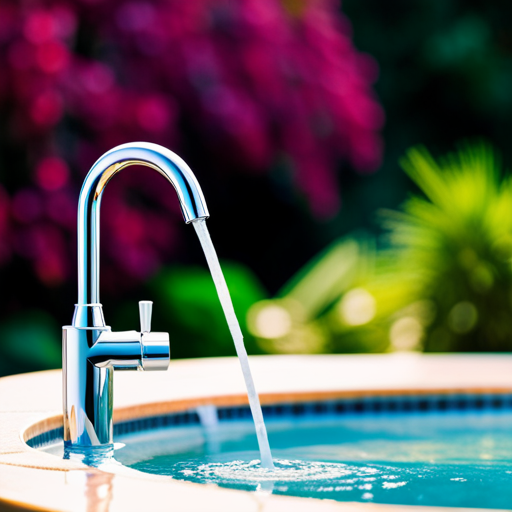Are you concerned about the quality of your drinking water? Lead contamination can be a serious health issue, but fortunately, there is a solution: faucet filters.
In this ultimate guide to faucet filters, you’ll learn everything you need to know about selecting the right one for your home. First, we’ll explore the basics of filtration and why it’s important to choose a filter with high lead removal capacity and NSF/ANSI Standard 53 certification.
Then, we’ll dive into the top brands and models available on the market and the key features that set them apart. Finally, we’ll discuss maintenance and replacement considerations, as well as other filtration methods and the overall benefits of using a faucet filter.
Whether you’re looking to improve the taste and quality of your drinking water or are concerned about lead contamination, this guide will provide valuable information to help you make an informed decision and enjoy lead-free sips.
Key Takeaways
– Faucet filters offer health benefits by reducing the risk of lead poisoning and improving the taste and odor of water.
– High lead removal capacity and NSF/ANSI Standard 53 certification are important factors to consider when choosing a filter.
– Maintenance and replacement of faucet mount filters is crucial for their effectiveness and longevity.
– Faucet filters can provide a more sustainable and eco-friendly option compared to other filtration methods.
Filtration Basics
You already know about the importance of high lead removal capacity and NSF/ANSI Standard 53 certification, but let’s dive into the basics of filtration and how it works in faucet filters.
Faucet filters use different types of filtration to remove contaminants from your drinking water. The three main stages of filtration are pre-filtration, primary filtration, and post-filtration.
Pre-filtration removes larger particles and sediments from the water, while primary filtration removes contaminants such as lead, chlorine, and bacteria. Post-filtration is used to improve the taste and odor of the water.
Faucet filters offer many health benefits, including reducing the risk of lead poisoning, improving the taste and odor of your water, and providing a more sustainable and cost-effective alternative to bottled water.
The different types of filtration used in faucet filters, such as activated carbon and reverse osmosis, offer varying levels of contaminant removal. It’s important to choose a faucet filter that is certified by NSF/ANSI and to replace the filter regularly to ensure optimum performance and continued health benefits.
Top Brands and Models
Check out the top brands and models of faucet mount filters for reliable and efficient lead removal from your tap water. Here are four options that have been highly rated for their features and NSF certification:
1. PUR PLUS – This model has a high lead removal capacity and a filter life indicator to let you know when it’s time to replace the cartridge. It also has an easy-to-use switch for filtered or unfiltered water.
2. Brita Basic – This budget-friendly option still has NSF certification and a filter life of up to four months. It’s easy to install and has a sleek design.
3. Culligan CFM-300CR – This filter has a chrome finish and a high flow rate of 1 gallon per minute. It uses a carbon block filter and has a filter change reminder sticker.
4. Aquasana Claryum 3-Stage Max Flow – This advanced filter uses a combination of activated carbon, ion exchange, and sub-micron filtration to remove a variety of contaminants, including lead. It has a filter life of up to six months and is easy to install and maintain.
When choosing a faucet mount filter, make sure to consider the specific features that are important to you, such as filter life, flow rate, and ease of installation. Also, look for products that have been certified by NSF for lead removal to ensure their effectiveness.
Maintenance and Replacement
Maintaining and replacing your faucet mount filter is crucial to ensure its effectiveness and longevity. Most faucet filters come with a recommended filter lifespan, which can range from 2 to 6 months depending on the brand and usage frequency. It’s important to follow this guideline and replace your filter regularly to avoid clogging, reduced flow rate, and decreased filtration efficiency.
Some filters come with a filter replacement indicator that signals when it’s time to change the cartridge. However, it’s always a good idea to keep track of the filter usage and replacement schedule on your own to avoid any potential health risks from using an outdated filter.
When considering the maintenance and replacement cost of a faucet mount filter, it’s important to compare it with other filtration methods like reverse osmosis, activated carbon, ion exchange, and distillation. Faucet filters are generally more cost-effective than these alternatives, as they require minimal installation, no electricity, and only periodic filter replacement.
Additionally, faucet filters can save you money on bottled water and reduce plastic waste, making them a more sustainable and eco-friendly option. However, keep in mind that the cost of replacement cartridges can vary greatly depending on the brand and model, so it’s important to factor in this expense when deciding on a faucet filter.
Conclusion
Congratulations! You’ve just completed the ultimate guide to faucet filters.
By now, you should have a solid understanding of the importance of high lead removal capacity and NSF/ANSI Standard 53 certification when selecting a faucet filter.
You also know the top brands and key features of popular faucet mount filters, as well as compatibility and maintenance considerations.
Remember, using a faucet filter is an easy and cost-effective way to improve the taste and quality of your drinking water. By removing contaminants like lead, you can protect yourself and your family from potential health risks.
And with proper maintenance and replacement, your faucet filter can continue to provide clean and safe drinking water for months to come.
So, go ahead, take a sip of lead-free water and enjoy the peace of mind that comes with knowing you’re taking steps to safeguard your health.
Thank you for reading and happy filtering!
